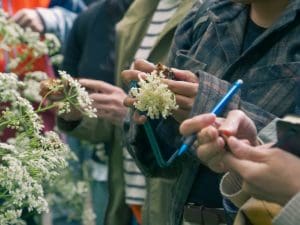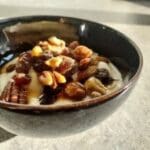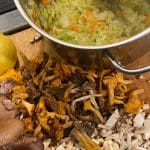Through this post we’re going to look at a secret trick to making Almost Instant Elderflower Gin.
In the past, when I’ve asked more experienced foragers than myself how they make alcoholic infusions and fermentations, I have been a little irritated when they’ve said, “well, I just make it up as I go along” or words to that effect. But a little experience does prove the validity of their words.
For example, many recipes for Elderflower gin (and cordial and sparkling wine) tell you to use a certain number of Elderflower heads. However, when you go out into the world and meet an Elder tree, bid them good morning/afternoon/evening, and politely request permission to take some of their flowers (always respect your elders {and indeed all flora and fauna}), you find that each of their flower heads is a different size, which, I feel, makes the recipe a little ambiguous.
I was once told that if a recipe calls for a clove of garlic you just use one clove of garlic – whatever size it is – because each clove contains the same amount of flavour. Maybe it is the same for flower heads of Elder, ie, whatever their size, they all contain the same amount of flavour….?
Meh – if the cloves of garlic are small, I use two!
But this is an experiment and therefore rigorous methodology is called for.
Proportions of ingredients used are loosely based on infused gin recipes found in books and on the web.
Find our Full Elderflower Foraging Guide Here

Equipment for my Almost Instant Elderflower Gin:
- A 3.25 litre Tupperware thing that fits nicely inside my shoulder bag
- Foraging knife for cutting Elderflower heads from trees
- Nitrous Oxide Whipped Cream Charger
- Nitrous Oxide Canister
- Coffee filter paper
- Funnel
- Saucepan
- 500ml plastic bottler (formerly a fresh spring water bottle).

Ingredients:
- 75g Elderflowers, collected on a warm, early summer morning (sandals, shorts and T-shirt warm – the type of day when the Elderflowers are producing as much aromatic oil as they can to attract pollinators)
- 500ml gin
- 2 tbsp sugar
Method:
It was early summer and the Elder had only been flowering for about a week, so the flower heads ranged in size from 5 – 15cm across. In a few days they should reach 20cm across, or more.
- Elderflower heads were removed from the tree using the foraging knife and placed in to the 3.25 litre Tupperware thing until it was approximately three-quarters full. This took less than an hour and the flower heads were loosely packed.
- NB/ when the individual flower heads are bigger the stalks will be thicker and occupy a greater volume, therefore a comparable volume of flower heads will contain fewer flowers.
- On returning home, the individual flowers were pulled from the stems using a fork and collected in a mixing bowl. The stubborn flowers were eased from their stalks manually. 75g of flowers were collected.
- The flowers were placed into the Nitrous Oxide Whipped Cream Charger.
- 500ml gin was added to the charger.
- The nitrous oxide canister was placed inside the canister cap and the cap and canister were screwed into the charger’s attachment dock until a hissing noise was heard, indicating the release of nitrous oxide into the charger.
- The charger was shaken vigorously for approximately 60 seconds (I counted to 100).
- The charger was allowed to stand for 20 minutes.
- The excess gas was released from the charger by keeping it standing in an upright position and gently depressing the lever which usually initiates the squirting of cream. A tea towel was held close to the spout that cream usually squirts from to catch any liquid accidentally released. As the lever was depressed the release of gas was indicated by a hissing sound. A spluttering sound was heard when liquid was accidentally released. On hearing a spluttering sound the pressure on the lever was released and the charger was left to stand for 5 – 10 seconds. The lever was pressed again to release more gasses until further release of liquid caused a spluttering sound. This was repeated until the amount of spluttering was greater than the amount of hissing.
- A coffee filter paper – the triangularish type used in coffee filter machines – was placed inside a funnel.
- The funnel was positioned above a measuring jug
- The contents of the Nitrous Oxide Whipped Cream Charger were decanted into the lined funnel and allowed to filter into the measuring jug.
- The filter paper was squeezed to release all juices from the organic material remaining in the funnel.
- Two tablespoons of sugar were weighed and placed into a saucepan.
- The filtered liquid in the measuring jug was added to the saucepan.
- The saucepan was placed on a stove and heated until all the sugar had dissolved.
- The solution was tested by the author and deemed to taste good.
- The solution was transferred to a 500ml bottle.
- A small sample of the solution was added to a mixer in the ratio of approximately 1:10
- The mixture was tested by the author and deemed to taste good!
Points of Interest in my Almost Instant Elderflower Gin Experiment
This experiment employed the use of a Nitrous Oxide Whipped Cream Charger. The mouth of this charger, through which the contents were placed, is 4cm in diameter. This meant that the methodology used in other, more traditional recipes for Elderflower infusions, which specify placing whole flower heads (stems and all) into a large jar or jug before covering with gin, was not suitable. Hence the necessity of separating the flowers from their stems.
The methodology described above also reduces risks associated with the potential toxicity of the Elder tree. The Elderflowers and Elderberries are the only edible and flavoursome part of the Elder tree. Other parts of the tree – the leaves and bark, for example, contain cyanogenic glycosides and neurotoxic alkaloids, which have the reputation of transporting consumers to the faery realm, which is probably not as much fun as it sounds! Records show that some people don’t make it back from that realm at all. The glycosides and alkaloids can be denatured (rendered harmless) by heating the plant material above 60oC. In the methodology described here, heating the gin/elderflower solution to dissolve the sugar may result in a temperature rise up to 60 oC. This temperature may not necessarily be reached but separating the flowers from their stems will also reduce the risk presented by toxic substances.
Conclusion
The experiment was successful. The flavour of elderflower was infused into the gin in a matter of minutes. In the interest of accuracy, it was deemed that a further sample be tested immediately to provide a more accurate description of the flavour.
A small amount of the solution was added to a glass.
On approaching the solution with one’s nose, the floral aroma of elderflower is immediately recognisable. On tasting the solution, the palate experiences a heat from the spirit used (gin) and a delicious floral sweetness which enhances the aromatic sensation experienced by the nose.
Many recipes will recommend adding lemon zest or lemon juice to the recipe but, having experimented with those recipes in the past, I have found that this results in a liquid which is more lemony than elderflowery. The two flavours certainly complement each other, but you can always get tonic water with a twist of lemon to go with your afternoon G & Elderflower T.
It is suggested that 75g of Elderflowers per 500ml Gin is an adequate ratio of flowers to spirit to ensure a flavourful infusion. Further research is required to specify a minimum and maximum ratios of flowers to gin.
Research is ongoing 🙂 Hic!
Find more amazing Wild Food recipes here:








